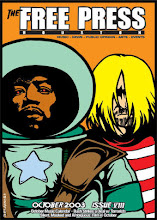Avatar
No amount of souped-up home entertainment television gear will ever equal the feeling of being theatrically immersed in the 3D world of James Cameron's Avatar. Yet one has to ask, is Cameron a day late and a dollar short? Yes he has once again supercharged cinema out of its franchise stupor, but only at the cost of creating another franchise. True that, Avatar must be seen in a theater preferably in 3D and preferably after that in IMAX 3D. However it's only a matter of scant years (2015) before technology places 3D wraparound television that a person can experience from any angle without wearing any visual devices.
Avatar works as cinema and also as stupendous sci-fi adventure. Additionally there's a heart healthy spiritual theme involving the synergy of the indigenous inhabitants of planet Pandora and their mother nature. The protags are 12-foot blue beings called Na'vi and the baddies are marines from Earth who have orders to remove the Na'vi, from an area wanted for its minerals, by any means necessary.
There's as much technology behind the film as on the screen. Cameron spent years developing a new kind of 3D camera and then years making the film. In fact the same 3D camera was used for Journey to the Center of the Earth and that came out two years ago. Cameron, of course, is the director of Titanic and the first two Terminator movies. It's a fair assessment that Avatar cost hundreds of millions and is the most expensive movie made to date, yet the money spent will be amortized over several projects. Talking about the money of Avatar makes little sense since that actually has little or nothing to do with the wow factor of Avatar.
By immersing the audiences in a spatial environment and not using the 3D effects for, say, a spear being hurled at the viewer, Avatar succeeds in creating the sense of a distant planet and alien beings. The combination of live action with a CGI rainforest is so seamless you don't register that most of the movie was created in a computer rather than on a set. Films like 300 are light years away from what Cameron has done with green screens and motion capture.
A marine who's lost the use of his legs gets a chance to walk again via an avatar, or in this case a laboratory alien that scientists can grow with a mixture of human DNA. This allows a human to occupy the alien on planet Pandora and thus move around without an oxygen mask or other life support. Meanwhile the human lies in a chamber like device in a dream state. We know the date is August 24, 2154 because that's the text at the bottom of the hero's videolog.
Avatar may not be the greatest film ever made, but it's a good enough film to become a huge hit and to enjoy more than once. Remember see this film in 3D. The more you think about Avatar the more it becomes apparent that there's nothing bad about it at all.










